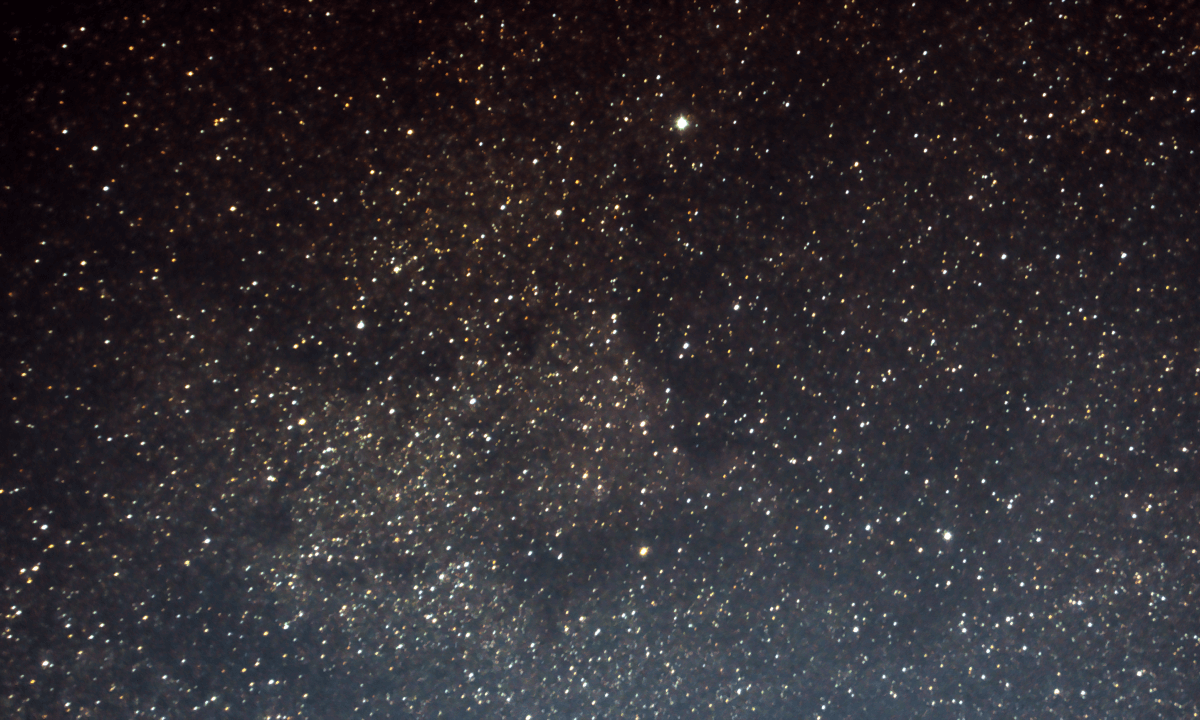The Target Nebula
My target for this was NGC 7000, aka the North American Nebula. It gets its name from similarities in its shape to that of the North American continent. NGC 7000 is 1,700 lightyears away from Earth and measures 100 lightyears across. It was first observed in 1786 and has been a favourite amongst amateur astronomers as it’s easy to locate, and can be seen with basic equipment.
I’ve tried on three occasions to get a picture of the North American Nebula since getting my first DLSR camera, the Nikon D5600. All three attempts took place within my garden, subject to a moderate amount of light pollution (4.3 Bortle). This post will show the results of the third and most recent attempt to capture this picture.
My Equipment
- Hardware:
- Nikon D5600
- 18-55mm lens
- A cheap tripod: How cheap? £10 on Amazon!
- Software:
- SnapBridge: Nikon’s smartphone app for taking pictures remotely
- DeepSkyStacker: For stacking the images
- G.I.M.P: For editing the stacked image
The Shoot
To see a full report of the evening, you can check out the related log.
I set up in my garden after noticing the sky was looking pretty clear. The weather reports seemed somewhat unsure, but I felt it was worth setting up and giving it a try. Each time I’ve set up to take a picture of this target, it’s climbed higher in the sky. As it’d been at least 3 weeks since my last attempt, this meant that the Nebula was in a really favourable position, as it was quite high in the sky by the time it got dark, reducing the effect of the light pollution.
By the end of the session, I had taken around 260 images at 400 ISO, f/5.6, with 8-second exposures. This included dark frames and biases to help with the stacking process. I have to keep my exposure times very low due to not having any hardware for tracking.
What went well
- I had set up and framed the subject very efficiently.
- My camera settings were more appropriate compared to my previous shoots.
What could have been better
Things didn’t go very well for me throughout the shoot, I’ll admit. I ran into a few problems:
- Nikon cameras can sometimes flick oil onto their sensors. This happened quite early on, and I had to take apart the camera in the dark to clean it.
- After making an adjustment, my mount started slowly leaning backwards over a 20-minute period. I finally noticed and found that I’d got some poorly framed shots as a result.
- After making some other adjustments, I must’ve accidentally touched the dial on the camera which changed the exposure time to 10 seconds, resulting in a dozen or so unusable shots.
- Without a dew ring, the camera lens ended the night with a thick layer of moisture on top. This won’t have helped the clarity and emphasises the need for me to get a dew ring before my next shoot.
Editing the image
I’m still very new to using DeepSkyStacker. I’ve made multiple attempts to stack my images and have found varying levels of success depending on the different settings. I’m certain that I could get a better result if I better understood this process and the various, complicated settings. But I’m happy with what I managed at this stage.
After importing the stack into G.I.M.P, I tried several techniques for cleaning the image up. For example, I’ve used background extraction to clean up the light pollution without removing details from the nebula itself. The editing stage in itself is also very complicated, as it introduces an artistic layer where the person editing the image has to make creative decisions over how things should look. I’m not at the level of deciding how I want things to look right now. My primary focus at this stage is making sure things are legible.
The final image
Camera: Nikon D5600
ISO-Speed: 400
F-stop: f/5.6
Exposure time: 16 minutes
Description: A field of stars with an orange cloud-like shape in the middle, NGC 7000 (the North American Nebula). The image is slightly noisy and has a natural blue gradient across the background.
The nebula itself is the orange cloud in the centre of the image. To see the North American silhouette, tilt your head to the left, so the bottom-right corner of the image is at the bottom.
Closing thoughts
I’m very happy with this image. Admittedly, it’s not that impressive, but for the first nebula I’ve photographed, considering the light pollution and limited equipment, I’m really happy I could achieve this result. I’ve learned a lot about what equipment to prioritise for my next shoot, and I’ve learned about the impact light pollution has on the editing process. I look forward to the next time I capture this target, so I can compare the results to today.

0 Comments